Analysis of Operations and Finance: A Report on Cucumber Ltd (ACC4029)
VerifiedAdded on 2023/01/11
|18
|3391
|42
Report
AI Summary
This report, focusing on Cucumber Ltd, a smartphone manufacturer, delves into various aspects of financial and operational management. It begins by defining management accounting and contrasting it with financial accounting, exploring different costing models like absorption costing, marginal costing, breakeven analysis, and activity-based costing. The report then applies investment appraisal techniques, including Accounting Rate of Return (ARR), Payback Period, Net Present Value (NPV), and Internal Rate of Return (IRR), to evaluate potential investment proposals, recommending the most financially viable options for the company. Furthermore, the report discusses the role of budgeting in operational management, analyzing variances in Cucumber Ltd's budget and proposing a flexible budgeting approach for improved accuracy. Finally, it examines the usefulness of the balanced scorecard, potentially creating a balanced scorecard for Cucumber Ltd to assess its performance across various dimensions. The analysis provides insights into financial planning, investment decisions, and performance evaluation within the context of a real-world case study.

Running head: MANAGE OPERATIONS AND FINANCE
Manage Operations and Finance
Name of the Student:
Name of the University:
Author’s Note
Manage Operations and Finance
Name of the Student:
Name of the University:
Author’s Note
Paraphrase This Document
Need a fresh take? Get an instant paraphrase of this document with our AI Paraphraser
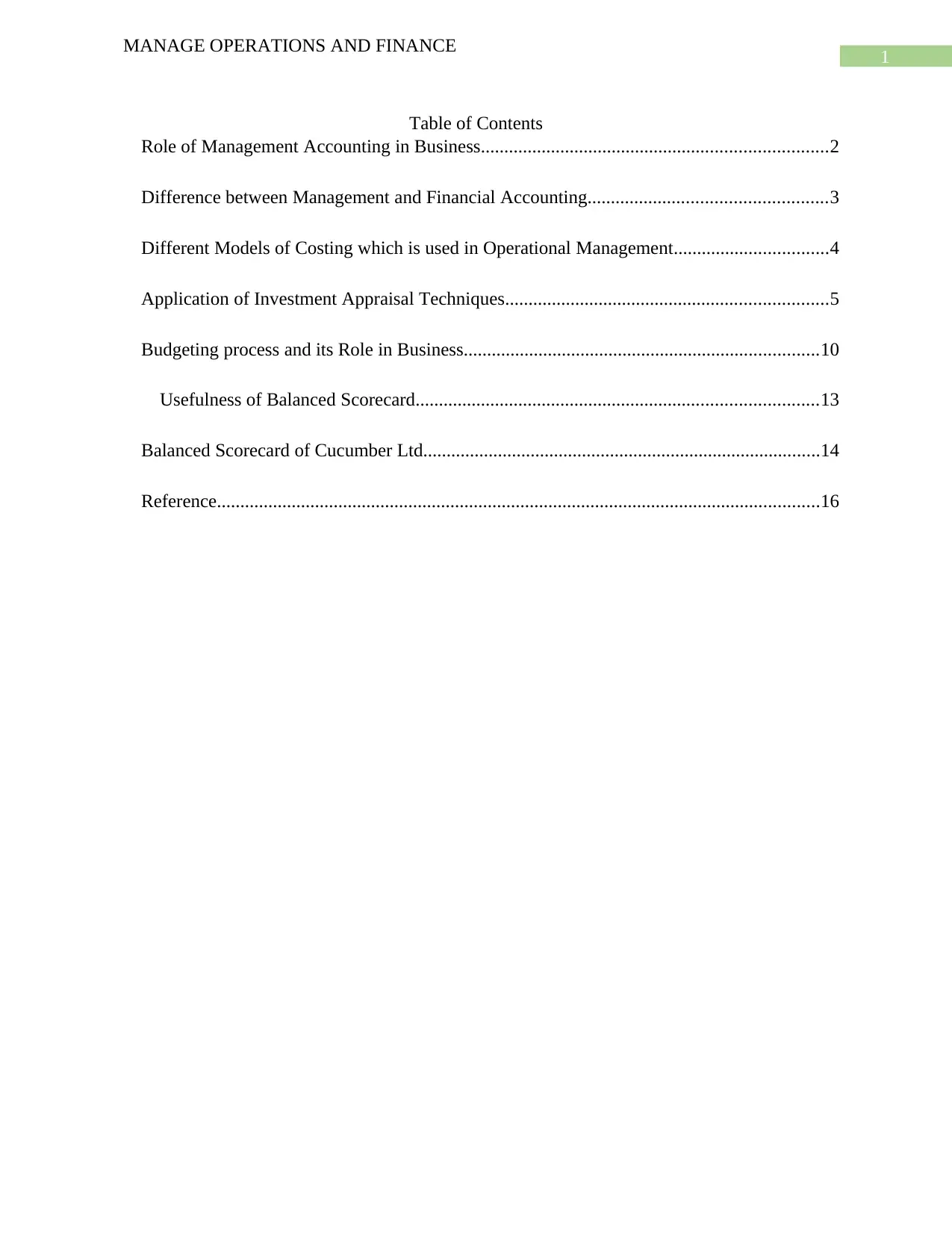
1
MANAGE OPERATIONS AND FINANCE
Table of Contents
Role of Management Accounting in Business..........................................................................2
Difference between Management and Financial Accounting...................................................3
Different Models of Costing which is used in Operational Management.................................4
Application of Investment Appraisal Techniques.....................................................................5
Budgeting process and its Role in Business............................................................................10
Usefulness of Balanced Scorecard......................................................................................13
Balanced Scorecard of Cucumber Ltd.....................................................................................14
Reference.................................................................................................................................16
MANAGE OPERATIONS AND FINANCE
Table of Contents
Role of Management Accounting in Business..........................................................................2
Difference between Management and Financial Accounting...................................................3
Different Models of Costing which is used in Operational Management.................................4
Application of Investment Appraisal Techniques.....................................................................5
Budgeting process and its Role in Business............................................................................10
Usefulness of Balanced Scorecard......................................................................................13
Balanced Scorecard of Cucumber Ltd.....................................................................................14
Reference.................................................................................................................................16
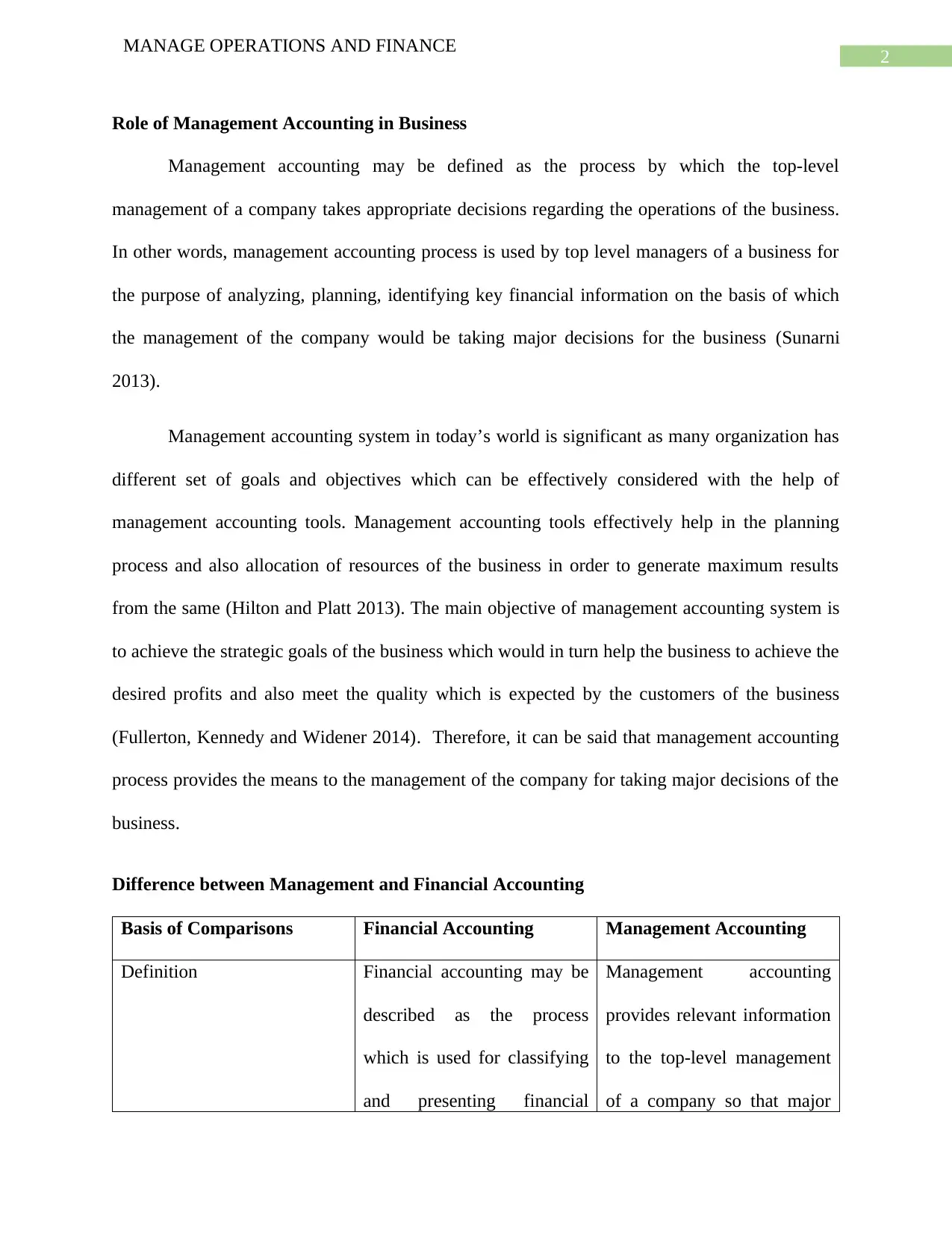
2
MANAGE OPERATIONS AND FINANCE
Role of Management Accounting in Business
Management accounting may be defined as the process by which the top-level
management of a company takes appropriate decisions regarding the operations of the business.
In other words, management accounting process is used by top level managers of a business for
the purpose of analyzing, planning, identifying key financial information on the basis of which
the management of the company would be taking major decisions for the business (Sunarni
2013).
Management accounting system in today’s world is significant as many organization has
different set of goals and objectives which can be effectively considered with the help of
management accounting tools. Management accounting tools effectively help in the planning
process and also allocation of resources of the business in order to generate maximum results
from the same (Hilton and Platt 2013). The main objective of management accounting system is
to achieve the strategic goals of the business which would in turn help the business to achieve the
desired profits and also meet the quality which is expected by the customers of the business
(Fullerton, Kennedy and Widener 2014). Therefore, it can be said that management accounting
process provides the means to the management of the company for taking major decisions of the
business.
Difference between Management and Financial Accounting
Basis of Comparisons Financial Accounting Management Accounting
Definition Financial accounting may be
described as the process
which is used for classifying
and presenting financial
Management accounting
provides relevant information
to the top-level management
of a company so that major
MANAGE OPERATIONS AND FINANCE
Role of Management Accounting in Business
Management accounting may be defined as the process by which the top-level
management of a company takes appropriate decisions regarding the operations of the business.
In other words, management accounting process is used by top level managers of a business for
the purpose of analyzing, planning, identifying key financial information on the basis of which
the management of the company would be taking major decisions for the business (Sunarni
2013).
Management accounting system in today’s world is significant as many organization has
different set of goals and objectives which can be effectively considered with the help of
management accounting tools. Management accounting tools effectively help in the planning
process and also allocation of resources of the business in order to generate maximum results
from the same (Hilton and Platt 2013). The main objective of management accounting system is
to achieve the strategic goals of the business which would in turn help the business to achieve the
desired profits and also meet the quality which is expected by the customers of the business
(Fullerton, Kennedy and Widener 2014). Therefore, it can be said that management accounting
process provides the means to the management of the company for taking major decisions of the
business.
Difference between Management and Financial Accounting
Basis of Comparisons Financial Accounting Management Accounting
Definition Financial accounting may be
described as the process
which is used for classifying
and presenting financial
Management accounting
provides relevant information
to the top-level management
of a company so that major
You're viewing a preview
Unlock full access by subscribing today!
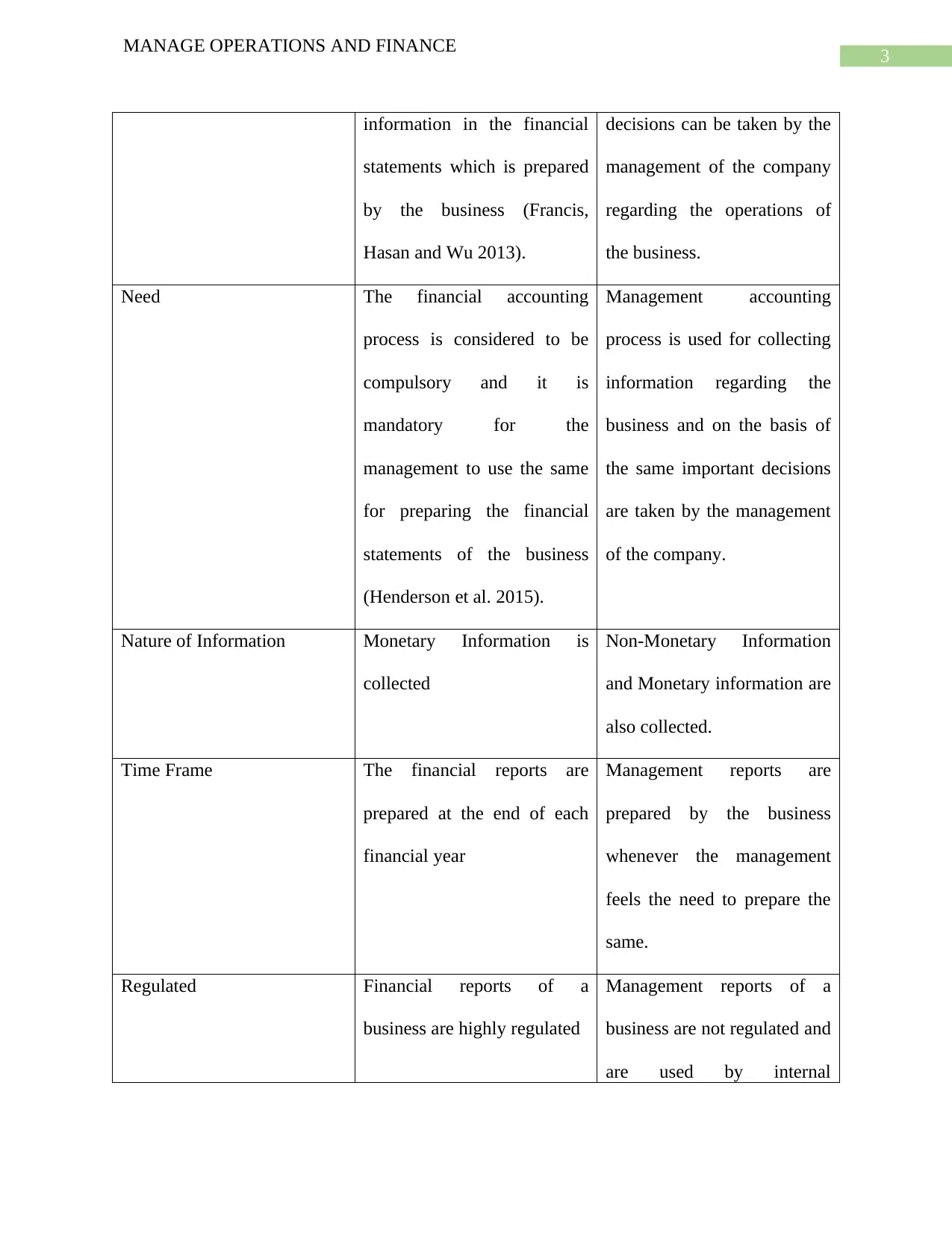
3
MANAGE OPERATIONS AND FINANCE
information in the financial
statements which is prepared
by the business (Francis,
Hasan and Wu 2013).
decisions can be taken by the
management of the company
regarding the operations of
the business.
Need The financial accounting
process is considered to be
compulsory and it is
mandatory for the
management to use the same
for preparing the financial
statements of the business
(Henderson et al. 2015).
Management accounting
process is used for collecting
information regarding the
business and on the basis of
the same important decisions
are taken by the management
of the company.
Nature of Information Monetary Information is
collected
Non-Monetary Information
and Monetary information are
also collected.
Time Frame The financial reports are
prepared at the end of each
financial year
Management reports are
prepared by the business
whenever the management
feels the need to prepare the
same.
Regulated Financial reports of a
business are highly regulated
Management reports of a
business are not regulated and
are used by internal
MANAGE OPERATIONS AND FINANCE
information in the financial
statements which is prepared
by the business (Francis,
Hasan and Wu 2013).
decisions can be taken by the
management of the company
regarding the operations of
the business.
Need The financial accounting
process is considered to be
compulsory and it is
mandatory for the
management to use the same
for preparing the financial
statements of the business
(Henderson et al. 2015).
Management accounting
process is used for collecting
information regarding the
business and on the basis of
the same important decisions
are taken by the management
of the company.
Nature of Information Monetary Information is
collected
Non-Monetary Information
and Monetary information are
also collected.
Time Frame The financial reports are
prepared at the end of each
financial year
Management reports are
prepared by the business
whenever the management
feels the need to prepare the
same.
Regulated Financial reports of a
business are highly regulated
Management reports of a
business are not regulated and
are used by internal
Paraphrase This Document
Need a fresh take? Get an instant paraphrase of this document with our AI Paraphraser
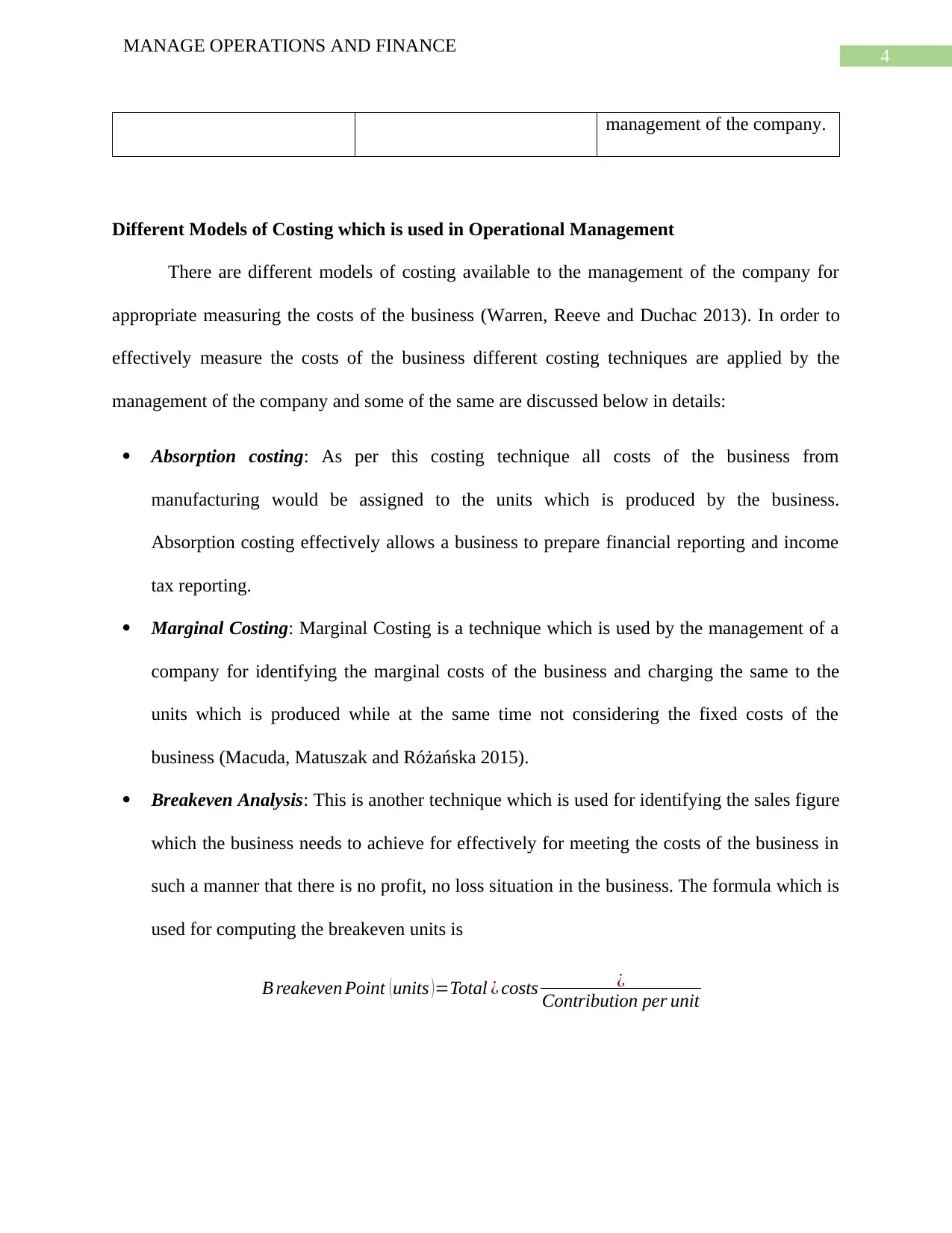
4
MANAGE OPERATIONS AND FINANCE
management of the company.
Different Models of Costing which is used in Operational Management
There are different models of costing available to the management of the company for
appropriate measuring the costs of the business (Warren, Reeve and Duchac 2013). In order to
effectively measure the costs of the business different costing techniques are applied by the
management of the company and some of the same are discussed below in details:
Absorption costing: As per this costing technique all costs of the business from
manufacturing would be assigned to the units which is produced by the business.
Absorption costing effectively allows a business to prepare financial reporting and income
tax reporting.
Marginal Costing: Marginal Costing is a technique which is used by the management of a
company for identifying the marginal costs of the business and charging the same to the
units which is produced while at the same time not considering the fixed costs of the
business (Macuda, Matuszak and Różańska 2015).
Breakeven Analysis: This is another technique which is used for identifying the sales figure
which the business needs to achieve for effectively for meeting the costs of the business in
such a manner that there is no profit, no loss situation in the business. The formula which is
used for computing the breakeven units is
B reakeven Point (units )=Total ¿ costs ¿
Contribution per unit
MANAGE OPERATIONS AND FINANCE
management of the company.
Different Models of Costing which is used in Operational Management
There are different models of costing available to the management of the company for
appropriate measuring the costs of the business (Warren, Reeve and Duchac 2013). In order to
effectively measure the costs of the business different costing techniques are applied by the
management of the company and some of the same are discussed below in details:
Absorption costing: As per this costing technique all costs of the business from
manufacturing would be assigned to the units which is produced by the business.
Absorption costing effectively allows a business to prepare financial reporting and income
tax reporting.
Marginal Costing: Marginal Costing is a technique which is used by the management of a
company for identifying the marginal costs of the business and charging the same to the
units which is produced while at the same time not considering the fixed costs of the
business (Macuda, Matuszak and Różańska 2015).
Breakeven Analysis: This is another technique which is used for identifying the sales figure
which the business needs to achieve for effectively for meeting the costs of the business in
such a manner that there is no profit, no loss situation in the business. The formula which is
used for computing the breakeven units is
B reakeven Point (units )=Total ¿ costs ¿
Contribution per unit
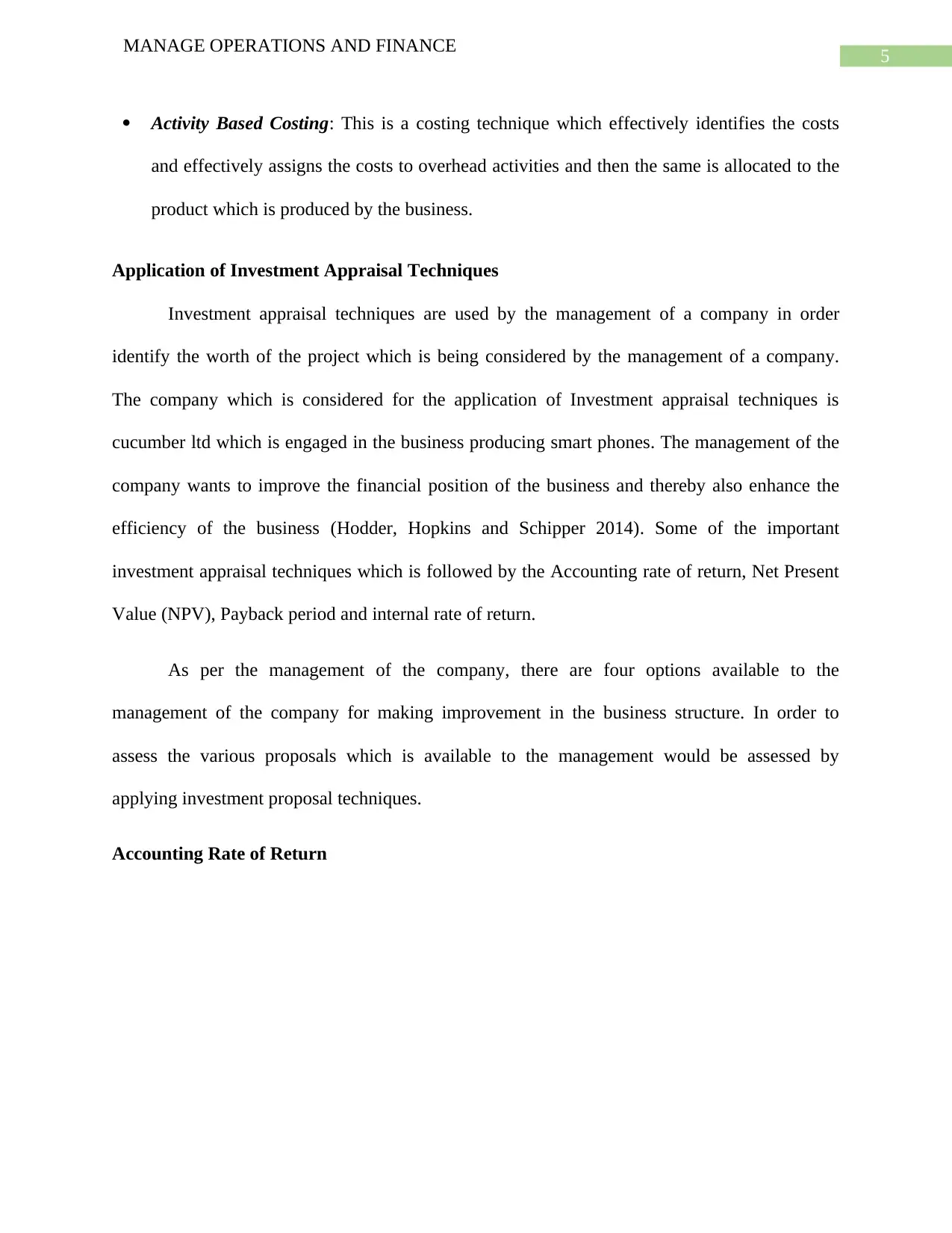
5
MANAGE OPERATIONS AND FINANCE
Activity Based Costing: This is a costing technique which effectively identifies the costs
and effectively assigns the costs to overhead activities and then the same is allocated to the
product which is produced by the business.
Application of Investment Appraisal Techniques
Investment appraisal techniques are used by the management of a company in order
identify the worth of the project which is being considered by the management of a company.
The company which is considered for the application of Investment appraisal techniques is
cucumber ltd which is engaged in the business producing smart phones. The management of the
company wants to improve the financial position of the business and thereby also enhance the
efficiency of the business (Hodder, Hopkins and Schipper 2014). Some of the important
investment appraisal techniques which is followed by the Accounting rate of return, Net Present
Value (NPV), Payback period and internal rate of return.
As per the management of the company, there are four options available to the
management of the company for making improvement in the business structure. In order to
assess the various proposals which is available to the management would be assessed by
applying investment proposal techniques.
Accounting Rate of Return
MANAGE OPERATIONS AND FINANCE
Activity Based Costing: This is a costing technique which effectively identifies the costs
and effectively assigns the costs to overhead activities and then the same is allocated to the
product which is produced by the business.
Application of Investment Appraisal Techniques
Investment appraisal techniques are used by the management of a company in order
identify the worth of the project which is being considered by the management of a company.
The company which is considered for the application of Investment appraisal techniques is
cucumber ltd which is engaged in the business producing smart phones. The management of the
company wants to improve the financial position of the business and thereby also enhance the
efficiency of the business (Hodder, Hopkins and Schipper 2014). Some of the important
investment appraisal techniques which is followed by the Accounting rate of return, Net Present
Value (NPV), Payback period and internal rate of return.
As per the management of the company, there are four options available to the
management of the company for making improvement in the business structure. In order to
assess the various proposals which is available to the management would be assessed by
applying investment proposal techniques.
Accounting Rate of Return
You're viewing a preview
Unlock full access by subscribing today!
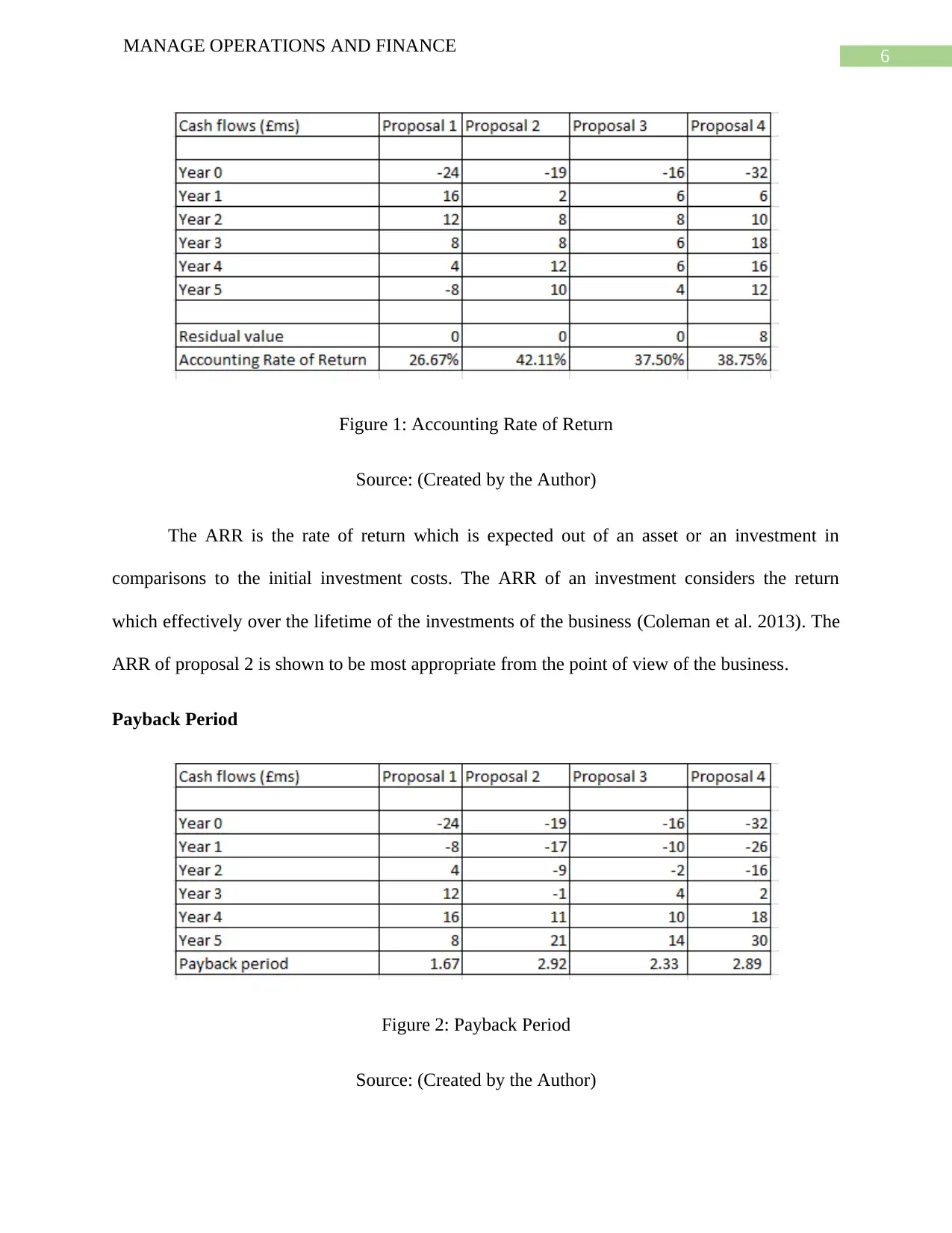
6
MANAGE OPERATIONS AND FINANCE
Figure 1: Accounting Rate of Return
Source: (Created by the Author)
The ARR is the rate of return which is expected out of an asset or an investment in
comparisons to the initial investment costs. The ARR of an investment considers the return
which effectively over the lifetime of the investments of the business (Coleman et al. 2013). The
ARR of proposal 2 is shown to be most appropriate from the point of view of the business.
Payback Period
Figure 2: Payback Period
Source: (Created by the Author)
MANAGE OPERATIONS AND FINANCE
Figure 1: Accounting Rate of Return
Source: (Created by the Author)
The ARR is the rate of return which is expected out of an asset or an investment in
comparisons to the initial investment costs. The ARR of an investment considers the return
which effectively over the lifetime of the investments of the business (Coleman et al. 2013). The
ARR of proposal 2 is shown to be most appropriate from the point of view of the business.
Payback Period
Figure 2: Payback Period
Source: (Created by the Author)
Paraphrase This Document
Need a fresh take? Get an instant paraphrase of this document with our AI Paraphraser
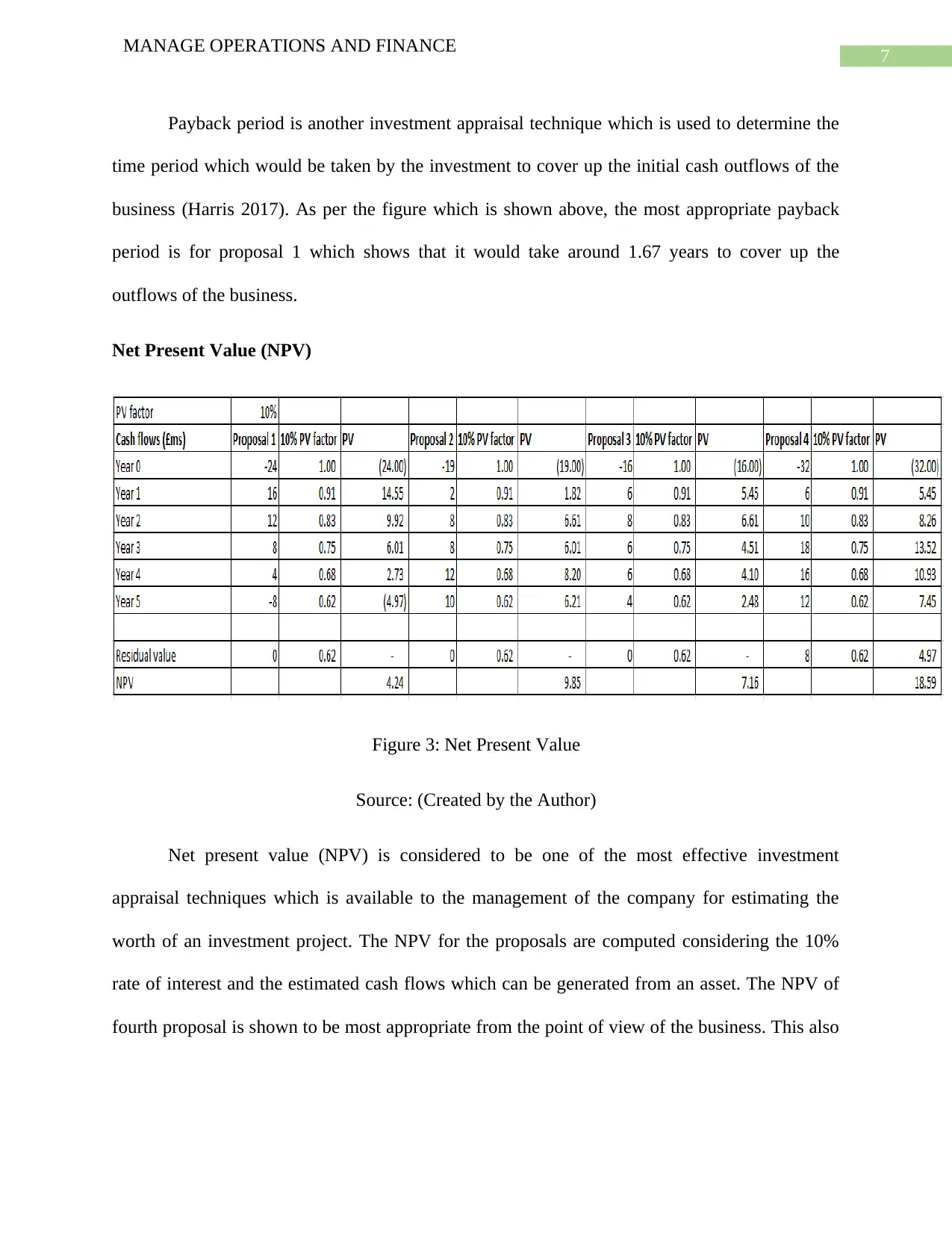
7
MANAGE OPERATIONS AND FINANCE
Payback period is another investment appraisal technique which is used to determine the
time period which would be taken by the investment to cover up the initial cash outflows of the
business (Harris 2017). As per the figure which is shown above, the most appropriate payback
period is for proposal 1 which shows that it would take around 1.67 years to cover up the
outflows of the business.
Net Present Value (NPV)
Figure 3: Net Present Value
Source: (Created by the Author)
Net present value (NPV) is considered to be one of the most effective investment
appraisal techniques which is available to the management of the company for estimating the
worth of an investment project. The NPV for the proposals are computed considering the 10%
rate of interest and the estimated cash flows which can be generated from an asset. The NPV of
fourth proposal is shown to be most appropriate from the point of view of the business. This also
MANAGE OPERATIONS AND FINANCE
Payback period is another investment appraisal technique which is used to determine the
time period which would be taken by the investment to cover up the initial cash outflows of the
business (Harris 2017). As per the figure which is shown above, the most appropriate payback
period is for proposal 1 which shows that it would take around 1.67 years to cover up the
outflows of the business.
Net Present Value (NPV)
Figure 3: Net Present Value
Source: (Created by the Author)
Net present value (NPV) is considered to be one of the most effective investment
appraisal techniques which is available to the management of the company for estimating the
worth of an investment project. The NPV for the proposals are computed considering the 10%
rate of interest and the estimated cash flows which can be generated from an asset. The NPV of
fourth proposal is shown to be most appropriate from the point of view of the business. This also
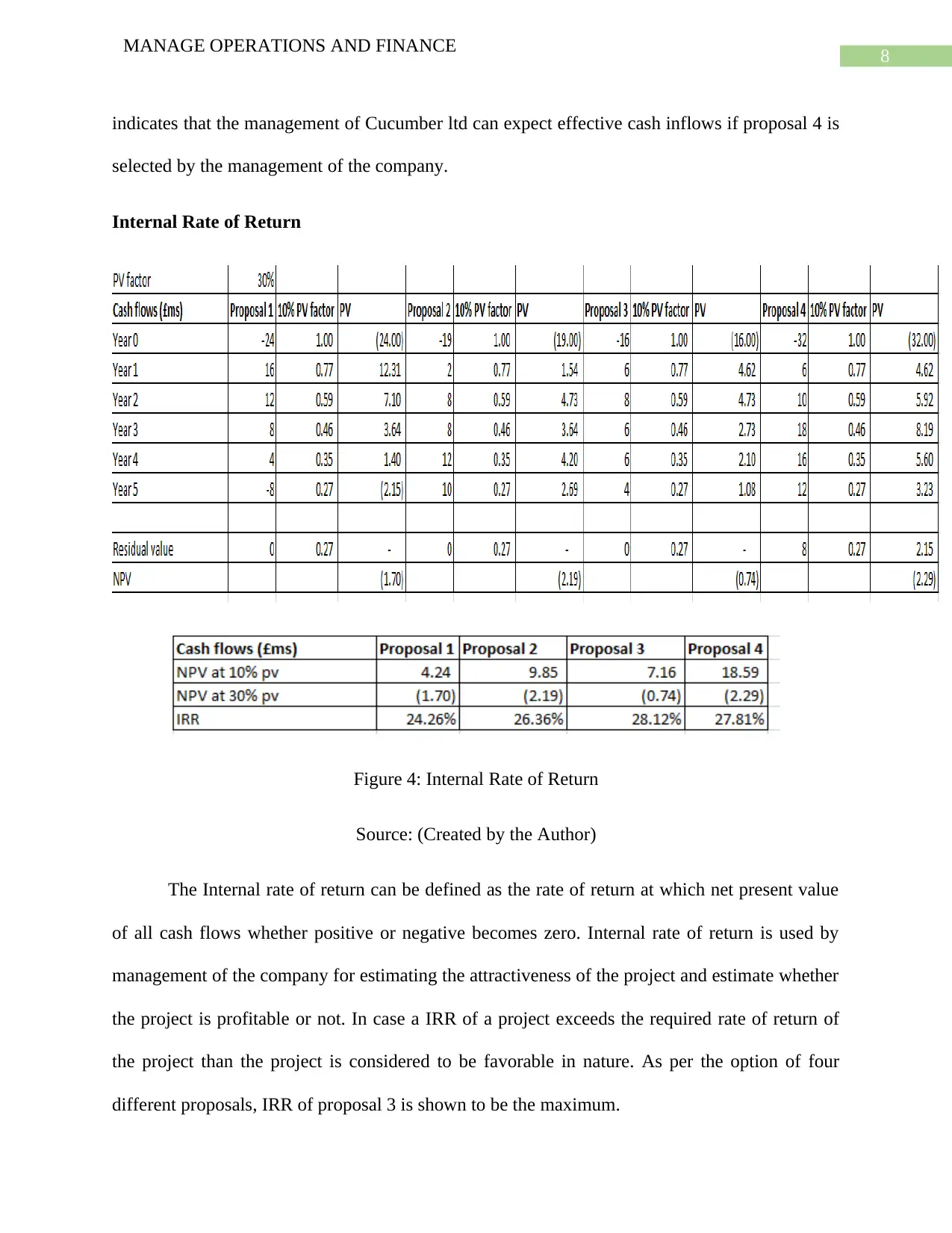
8
MANAGE OPERATIONS AND FINANCE
indicates that the management of Cucumber ltd can expect effective cash inflows if proposal 4 is
selected by the management of the company.
Internal Rate of Return
Figure 4: Internal Rate of Return
Source: (Created by the Author)
The Internal rate of return can be defined as the rate of return at which net present value
of all cash flows whether positive or negative becomes zero. Internal rate of return is used by
management of the company for estimating the attractiveness of the project and estimate whether
the project is profitable or not. In case a IRR of a project exceeds the required rate of return of
the project than the project is considered to be favorable in nature. As per the option of four
different proposals, IRR of proposal 3 is shown to be the maximum.
MANAGE OPERATIONS AND FINANCE
indicates that the management of Cucumber ltd can expect effective cash inflows if proposal 4 is
selected by the management of the company.
Internal Rate of Return
Figure 4: Internal Rate of Return
Source: (Created by the Author)
The Internal rate of return can be defined as the rate of return at which net present value
of all cash flows whether positive or negative becomes zero. Internal rate of return is used by
management of the company for estimating the attractiveness of the project and estimate whether
the project is profitable or not. In case a IRR of a project exceeds the required rate of return of
the project than the project is considered to be favorable in nature. As per the option of four
different proposals, IRR of proposal 3 is shown to be the maximum.
You're viewing a preview
Unlock full access by subscribing today!
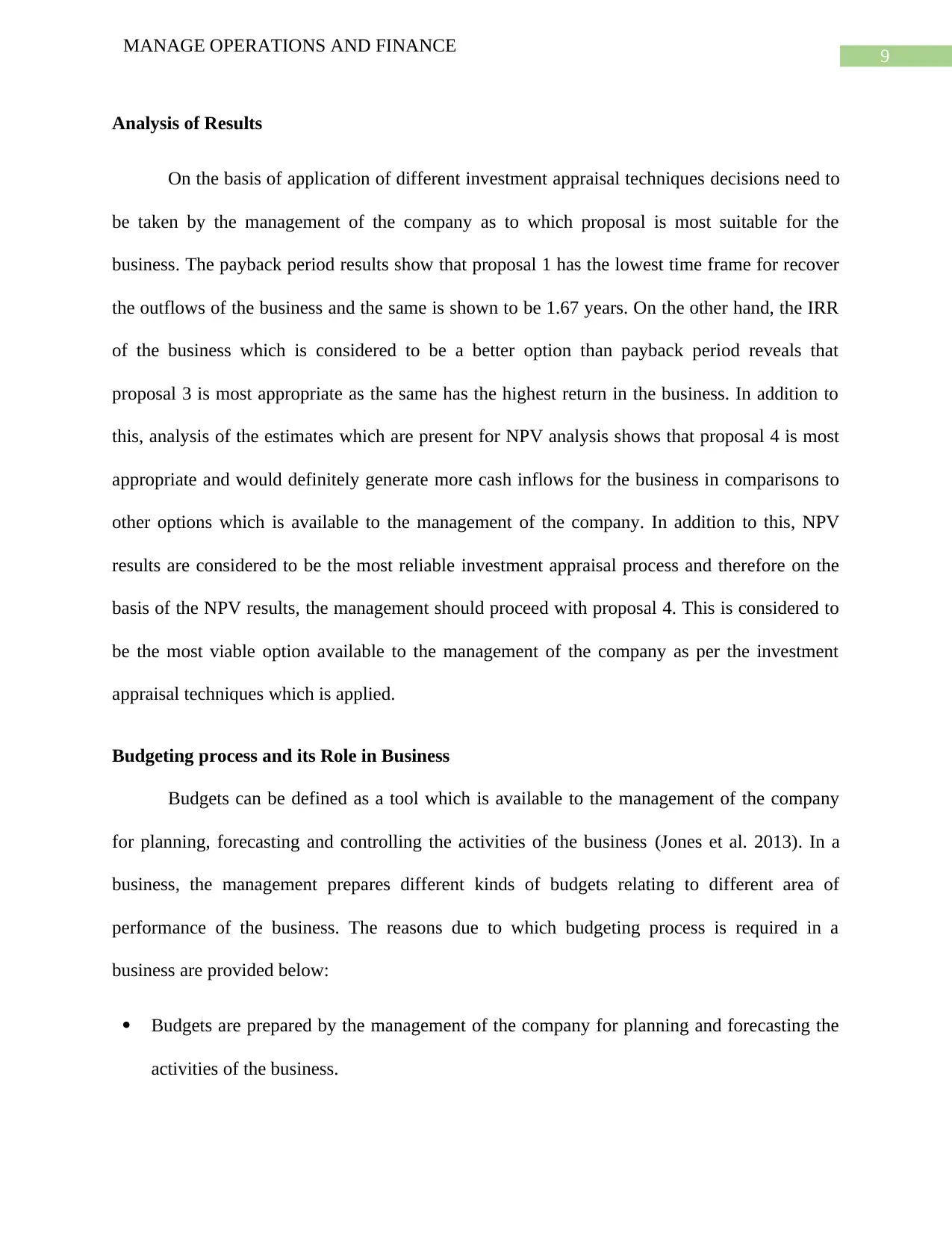
9
MANAGE OPERATIONS AND FINANCE
Analysis of Results
On the basis of application of different investment appraisal techniques decisions need to
be taken by the management of the company as to which proposal is most suitable for the
business. The payback period results show that proposal 1 has the lowest time frame for recover
the outflows of the business and the same is shown to be 1.67 years. On the other hand, the IRR
of the business which is considered to be a better option than payback period reveals that
proposal 3 is most appropriate as the same has the highest return in the business. In addition to
this, analysis of the estimates which are present for NPV analysis shows that proposal 4 is most
appropriate and would definitely generate more cash inflows for the business in comparisons to
other options which is available to the management of the company. In addition to this, NPV
results are considered to be the most reliable investment appraisal process and therefore on the
basis of the NPV results, the management should proceed with proposal 4. This is considered to
be the most viable option available to the management of the company as per the investment
appraisal techniques which is applied.
Budgeting process and its Role in Business
Budgets can be defined as a tool which is available to the management of the company
for planning, forecasting and controlling the activities of the business (Jones et al. 2013). In a
business, the management prepares different kinds of budgets relating to different area of
performance of the business. The reasons due to which budgeting process is required in a
business are provided below:
Budgets are prepared by the management of the company for planning and forecasting the
activities of the business.
MANAGE OPERATIONS AND FINANCE
Analysis of Results
On the basis of application of different investment appraisal techniques decisions need to
be taken by the management of the company as to which proposal is most suitable for the
business. The payback period results show that proposal 1 has the lowest time frame for recover
the outflows of the business and the same is shown to be 1.67 years. On the other hand, the IRR
of the business which is considered to be a better option than payback period reveals that
proposal 3 is most appropriate as the same has the highest return in the business. In addition to
this, analysis of the estimates which are present for NPV analysis shows that proposal 4 is most
appropriate and would definitely generate more cash inflows for the business in comparisons to
other options which is available to the management of the company. In addition to this, NPV
results are considered to be the most reliable investment appraisal process and therefore on the
basis of the NPV results, the management should proceed with proposal 4. This is considered to
be the most viable option available to the management of the company as per the investment
appraisal techniques which is applied.
Budgeting process and its Role in Business
Budgets can be defined as a tool which is available to the management of the company
for planning, forecasting and controlling the activities of the business (Jones et al. 2013). In a
business, the management prepares different kinds of budgets relating to different area of
performance of the business. The reasons due to which budgeting process is required in a
business are provided below:
Budgets are prepared by the management of the company for planning and forecasting the
activities of the business.
Paraphrase This Document
Need a fresh take? Get an instant paraphrase of this document with our AI Paraphraser
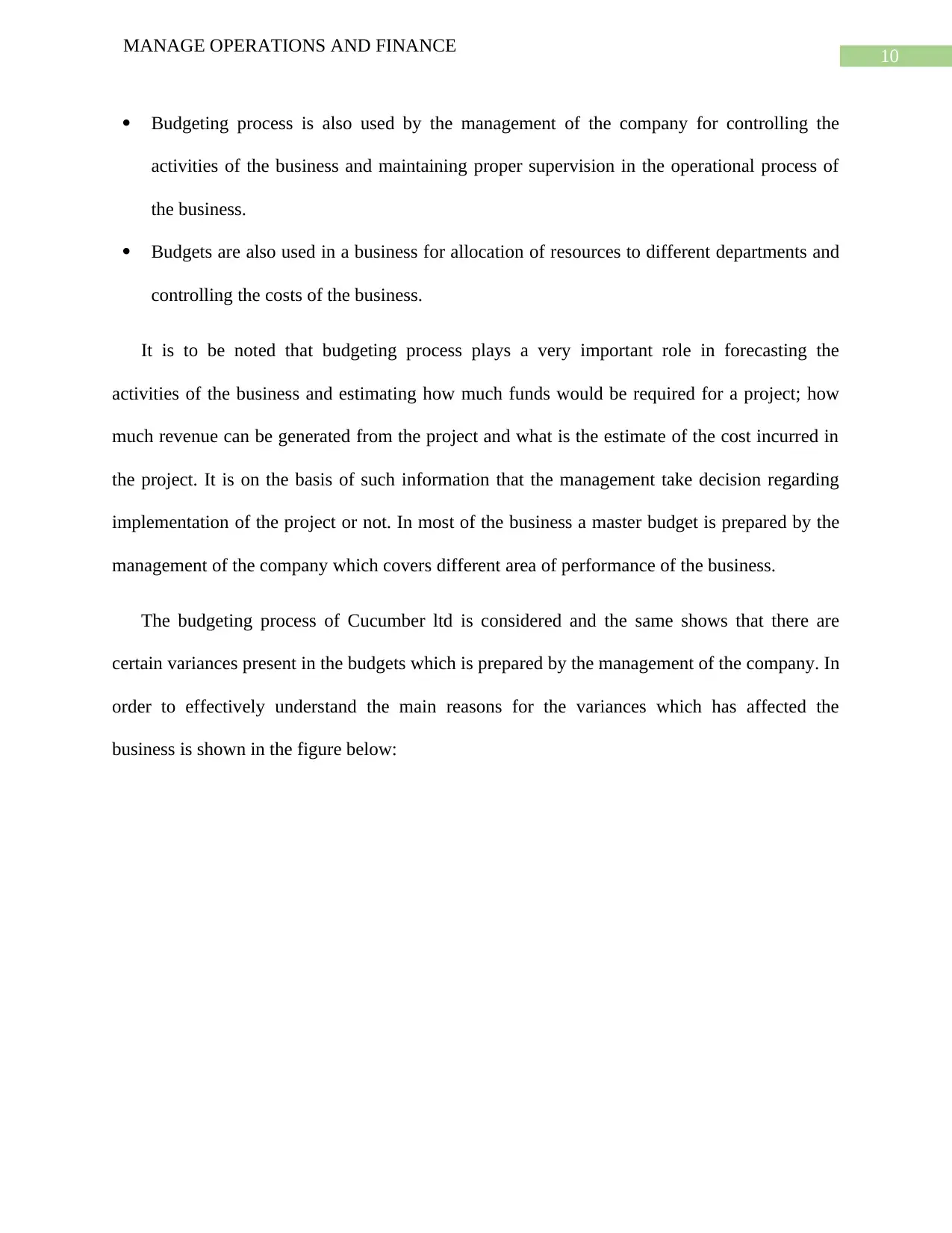
10
MANAGE OPERATIONS AND FINANCE
Budgeting process is also used by the management of the company for controlling the
activities of the business and maintaining proper supervision in the operational process of
the business.
Budgets are also used in a business for allocation of resources to different departments and
controlling the costs of the business.
It is to be noted that budgeting process plays a very important role in forecasting the
activities of the business and estimating how much funds would be required for a project; how
much revenue can be generated from the project and what is the estimate of the cost incurred in
the project. It is on the basis of such information that the management take decision regarding
implementation of the project or not. In most of the business a master budget is prepared by the
management of the company which covers different area of performance of the business.
The budgeting process of Cucumber ltd is considered and the same shows that there are
certain variances present in the budgets which is prepared by the management of the company. In
order to effectively understand the main reasons for the variances which has affected the
business is shown in the figure below:
MANAGE OPERATIONS AND FINANCE
Budgeting process is also used by the management of the company for controlling the
activities of the business and maintaining proper supervision in the operational process of
the business.
Budgets are also used in a business for allocation of resources to different departments and
controlling the costs of the business.
It is to be noted that budgeting process plays a very important role in forecasting the
activities of the business and estimating how much funds would be required for a project; how
much revenue can be generated from the project and what is the estimate of the cost incurred in
the project. It is on the basis of such information that the management take decision regarding
implementation of the project or not. In most of the business a master budget is prepared by the
management of the company which covers different area of performance of the business.
The budgeting process of Cucumber ltd is considered and the same shows that there are
certain variances present in the budgets which is prepared by the management of the company. In
order to effectively understand the main reasons for the variances which has affected the
business is shown in the figure below:
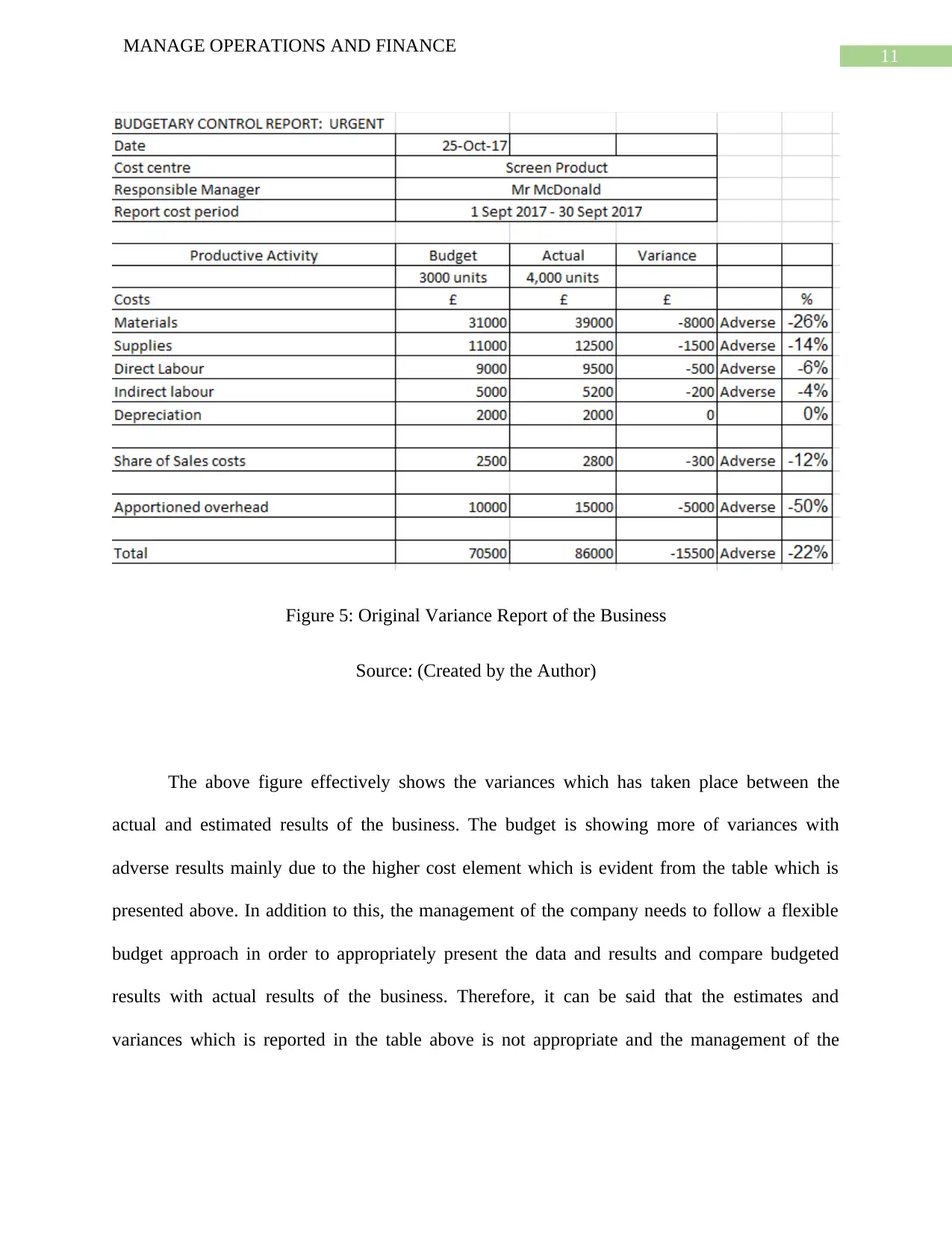
11
MANAGE OPERATIONS AND FINANCE
Figure 5: Original Variance Report of the Business
Source: (Created by the Author)
The above figure effectively shows the variances which has taken place between the
actual and estimated results of the business. The budget is showing more of variances with
adverse results mainly due to the higher cost element which is evident from the table which is
presented above. In addition to this, the management of the company needs to follow a flexible
budget approach in order to appropriately present the data and results and compare budgeted
results with actual results of the business. Therefore, it can be said that the estimates and
variances which is reported in the table above is not appropriate and the management of the
MANAGE OPERATIONS AND FINANCE
Figure 5: Original Variance Report of the Business
Source: (Created by the Author)
The above figure effectively shows the variances which has taken place between the
actual and estimated results of the business. The budget is showing more of variances with
adverse results mainly due to the higher cost element which is evident from the table which is
presented above. In addition to this, the management of the company needs to follow a flexible
budget approach in order to appropriately present the data and results and compare budgeted
results with actual results of the business. Therefore, it can be said that the estimates and
variances which is reported in the table above is not appropriate and the management of the
You're viewing a preview
Unlock full access by subscribing today!
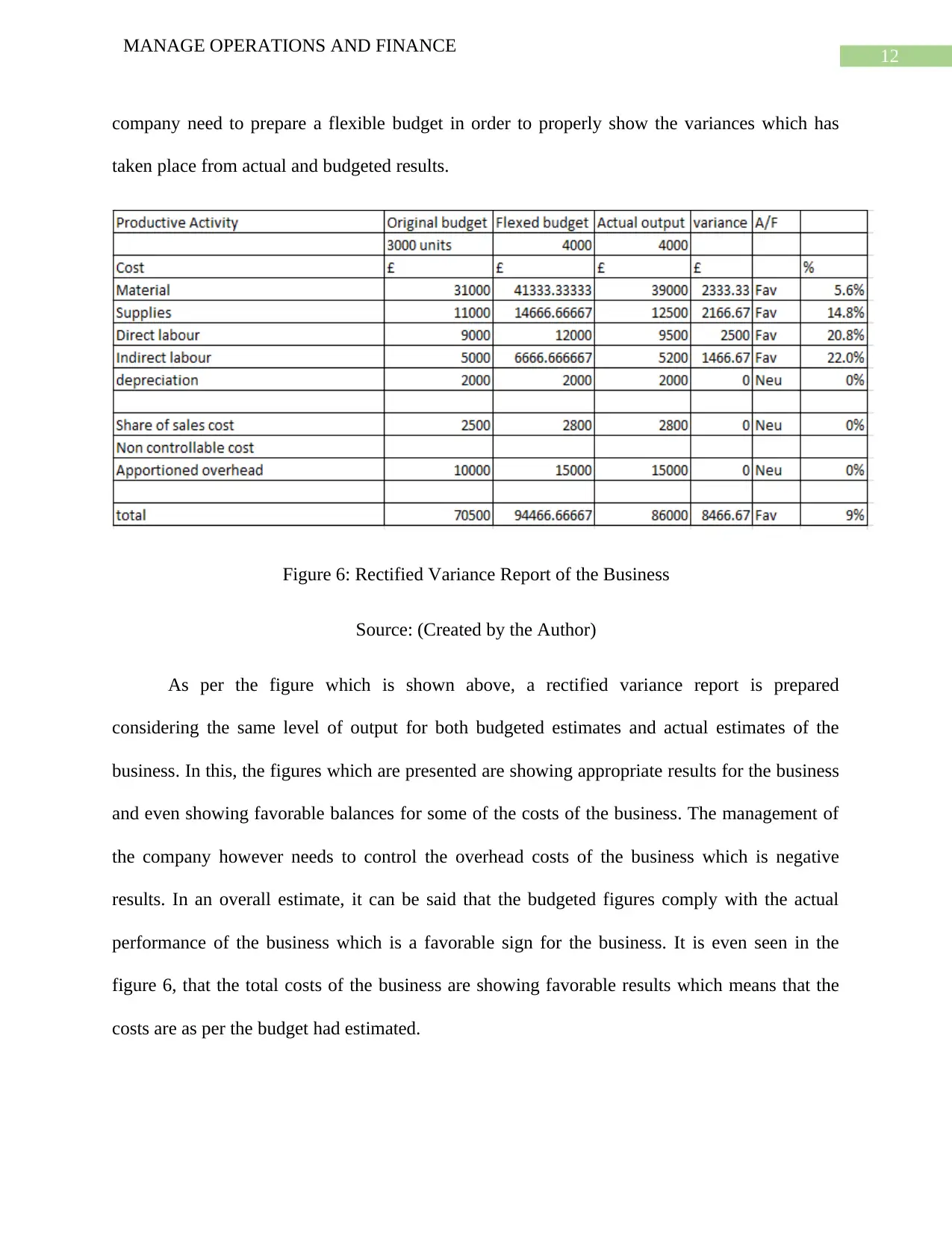
12
MANAGE OPERATIONS AND FINANCE
company need to prepare a flexible budget in order to properly show the variances which has
taken place from actual and budgeted results.
Figure 6: Rectified Variance Report of the Business
Source: (Created by the Author)
As per the figure which is shown above, a rectified variance report is prepared
considering the same level of output for both budgeted estimates and actual estimates of the
business. In this, the figures which are presented are showing appropriate results for the business
and even showing favorable balances for some of the costs of the business. The management of
the company however needs to control the overhead costs of the business which is negative
results. In an overall estimate, it can be said that the budgeted figures comply with the actual
performance of the business which is a favorable sign for the business. It is even seen in the
figure 6, that the total costs of the business are showing favorable results which means that the
costs are as per the budget had estimated.
MANAGE OPERATIONS AND FINANCE
company need to prepare a flexible budget in order to properly show the variances which has
taken place from actual and budgeted results.
Figure 6: Rectified Variance Report of the Business
Source: (Created by the Author)
As per the figure which is shown above, a rectified variance report is prepared
considering the same level of output for both budgeted estimates and actual estimates of the
business. In this, the figures which are presented are showing appropriate results for the business
and even showing favorable balances for some of the costs of the business. The management of
the company however needs to control the overhead costs of the business which is negative
results. In an overall estimate, it can be said that the budgeted figures comply with the actual
performance of the business which is a favorable sign for the business. It is even seen in the
figure 6, that the total costs of the business are showing favorable results which means that the
costs are as per the budget had estimated.
Paraphrase This Document
Need a fresh take? Get an instant paraphrase of this document with our AI Paraphraser
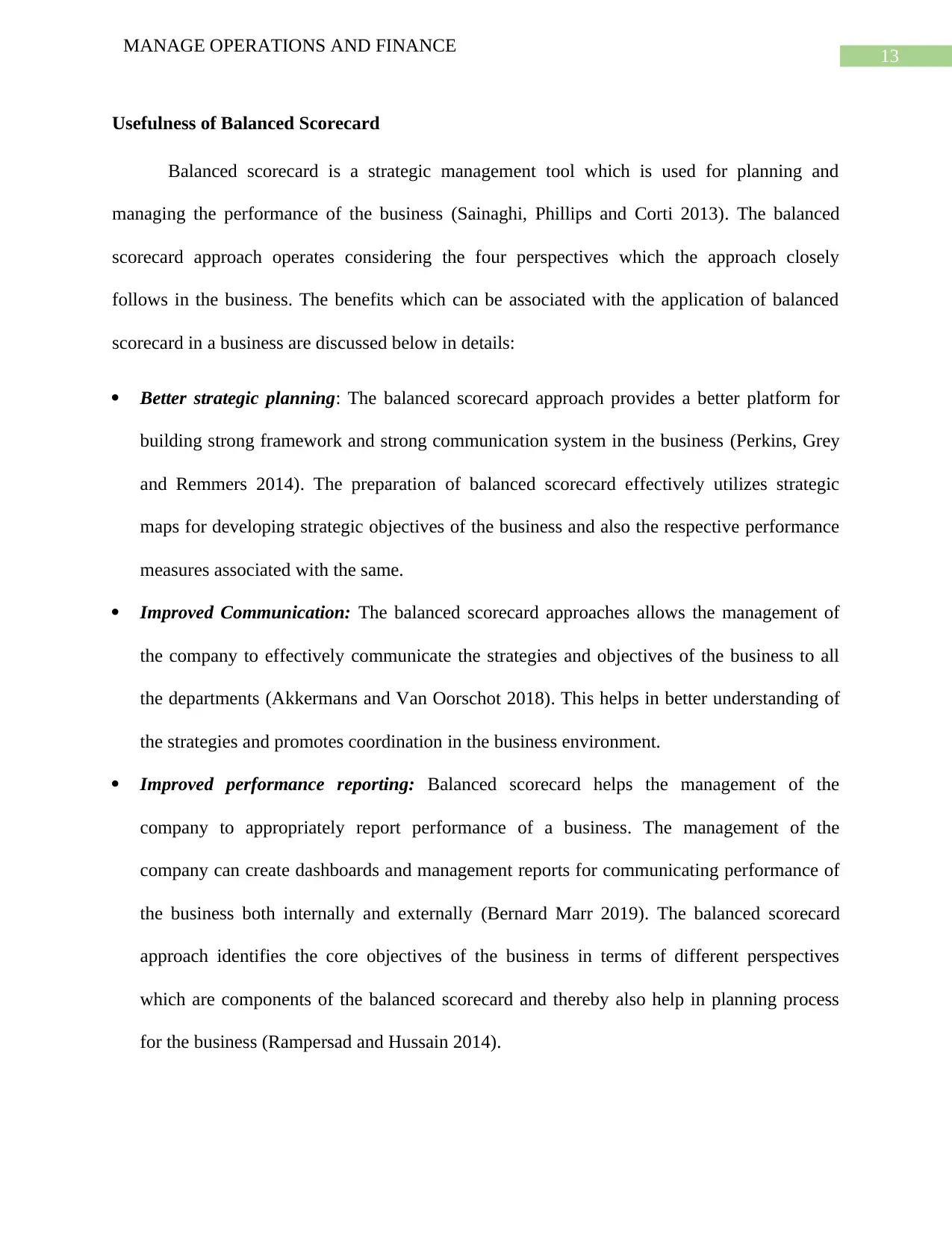
13
MANAGE OPERATIONS AND FINANCE
Usefulness of Balanced Scorecard
Balanced scorecard is a strategic management tool which is used for planning and
managing the performance of the business (Sainaghi, Phillips and Corti 2013). The balanced
scorecard approach operates considering the four perspectives which the approach closely
follows in the business. The benefits which can be associated with the application of balanced
scorecard in a business are discussed below in details:
Better strategic planning: The balanced scorecard approach provides a better platform for
building strong framework and strong communication system in the business (Perkins, Grey
and Remmers 2014). The preparation of balanced scorecard effectively utilizes strategic
maps for developing strategic objectives of the business and also the respective performance
measures associated with the same.
Improved Communication: The balanced scorecard approaches allows the management of
the company to effectively communicate the strategies and objectives of the business to all
the departments (Akkermans and Van Oorschot 2018). This helps in better understanding of
the strategies and promotes coordination in the business environment.
Improved performance reporting: Balanced scorecard helps the management of the
company to appropriately report performance of a business. The management of the
company can create dashboards and management reports for communicating performance of
the business both internally and externally (Bernard Marr 2019). The balanced scorecard
approach identifies the core objectives of the business in terms of different perspectives
which are components of the balanced scorecard and thereby also help in planning process
for the business (Rampersad and Hussain 2014).
MANAGE OPERATIONS AND FINANCE
Usefulness of Balanced Scorecard
Balanced scorecard is a strategic management tool which is used for planning and
managing the performance of the business (Sainaghi, Phillips and Corti 2013). The balanced
scorecard approach operates considering the four perspectives which the approach closely
follows in the business. The benefits which can be associated with the application of balanced
scorecard in a business are discussed below in details:
Better strategic planning: The balanced scorecard approach provides a better platform for
building strong framework and strong communication system in the business (Perkins, Grey
and Remmers 2014). The preparation of balanced scorecard effectively utilizes strategic
maps for developing strategic objectives of the business and also the respective performance
measures associated with the same.
Improved Communication: The balanced scorecard approaches allows the management of
the company to effectively communicate the strategies and objectives of the business to all
the departments (Akkermans and Van Oorschot 2018). This helps in better understanding of
the strategies and promotes coordination in the business environment.
Improved performance reporting: Balanced scorecard helps the management of the
company to appropriately report performance of a business. The management of the
company can create dashboards and management reports for communicating performance of
the business both internally and externally (Bernard Marr 2019). The balanced scorecard
approach identifies the core objectives of the business in terms of different perspectives
which are components of the balanced scorecard and thereby also help in planning process
for the business (Rampersad and Hussain 2014).
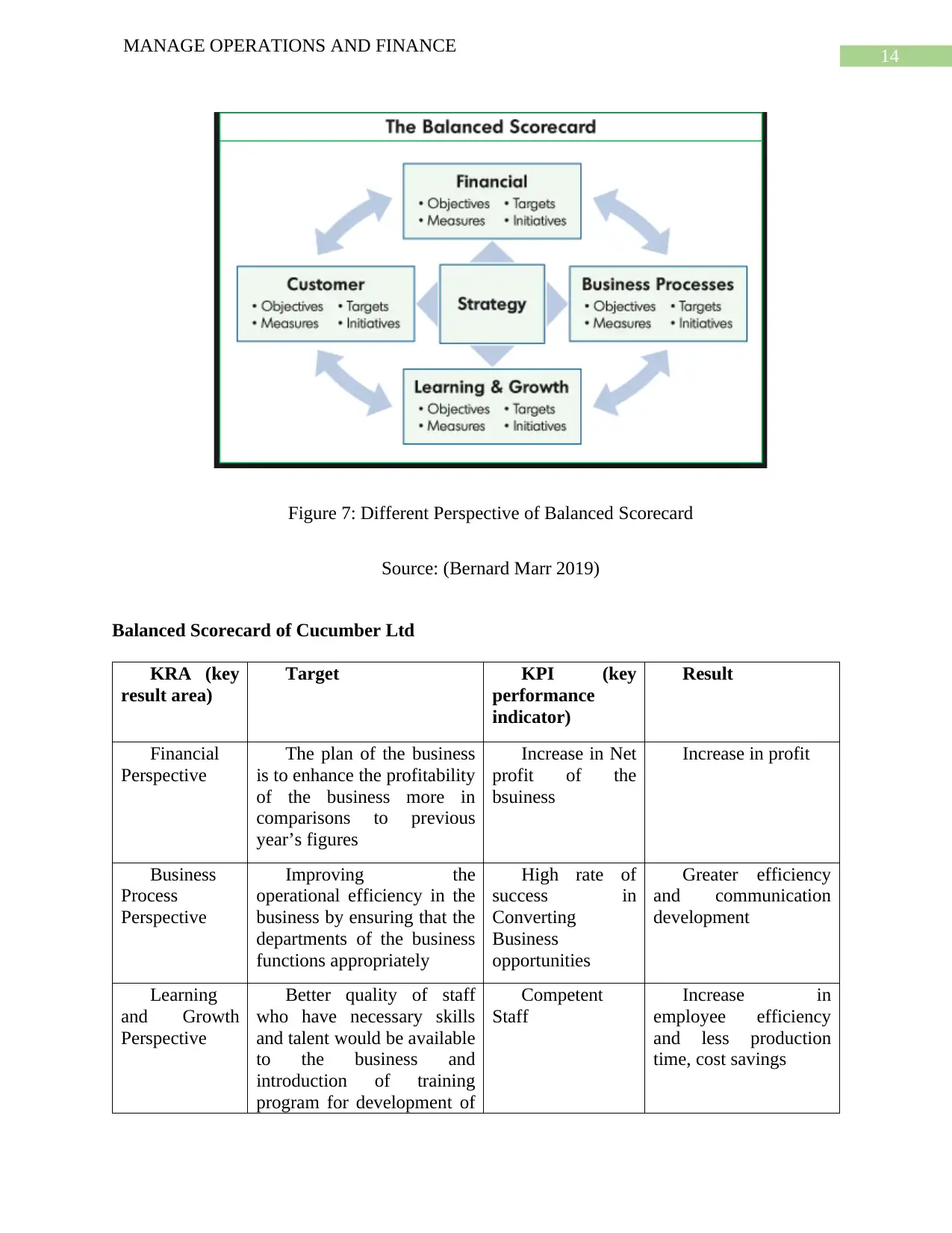
14
MANAGE OPERATIONS AND FINANCE
Figure 7: Different Perspective of Balanced Scorecard
Source: (Bernard Marr 2019)
Balanced Scorecard of Cucumber Ltd
KRA (key
result area)
Target KPI (key
performance
indicator)
Result
Financial
Perspective
The plan of the business
is to enhance the profitability
of the business more in
comparisons to previous
year’s figures
Increase in Net
profit of the
bsuiness
Increase in profit
Business
Process
Perspective
Improving the
operational efficiency in the
business by ensuring that the
departments of the business
functions appropriately
High rate of
success in
Converting
Business
opportunities
Greater efficiency
and communication
development
Learning
and Growth
Perspective
Better quality of staff
who have necessary skills
and talent would be available
to the business and
introduction of training
program for development of
Competent
Staff
Increase in
employee efficiency
and less production
time, cost savings
MANAGE OPERATIONS AND FINANCE
Figure 7: Different Perspective of Balanced Scorecard
Source: (Bernard Marr 2019)
Balanced Scorecard of Cucumber Ltd
KRA (key
result area)
Target KPI (key
performance
indicator)
Result
Financial
Perspective
The plan of the business
is to enhance the profitability
of the business more in
comparisons to previous
year’s figures
Increase in Net
profit of the
bsuiness
Increase in profit
Business
Process
Perspective
Improving the
operational efficiency in the
business by ensuring that the
departments of the business
functions appropriately
High rate of
success in
Converting
Business
opportunities
Greater efficiency
and communication
development
Learning
and Growth
Perspective
Better quality of staff
who have necessary skills
and talent would be available
to the business and
introduction of training
program for development of
Competent
Staff
Increase in
employee efficiency
and less production
time, cost savings
You're viewing a preview
Unlock full access by subscribing today!
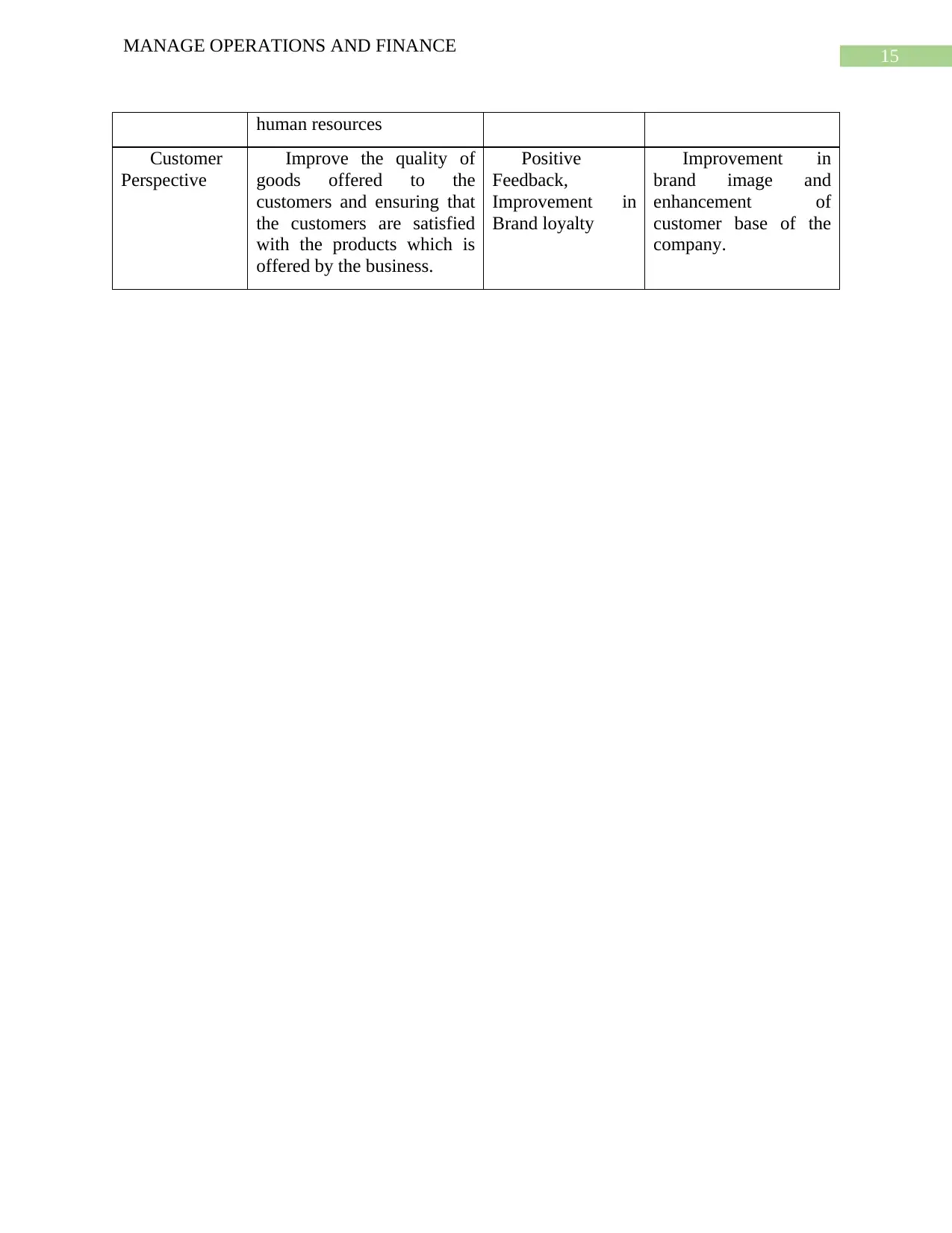
15
MANAGE OPERATIONS AND FINANCE
human resources
Customer
Perspective
Improve the quality of
goods offered to the
customers and ensuring that
the customers are satisfied
with the products which is
offered by the business.
Positive
Feedback,
Improvement in
Brand loyalty
Improvement in
brand image and
enhancement of
customer base of the
company.
MANAGE OPERATIONS AND FINANCE
human resources
Customer
Perspective
Improve the quality of
goods offered to the
customers and ensuring that
the customers are satisfied
with the products which is
offered by the business.
Positive
Feedback,
Improvement in
Brand loyalty
Improvement in
brand image and
enhancement of
customer base of the
company.
Paraphrase This Document
Need a fresh take? Get an instant paraphrase of this document with our AI Paraphraser
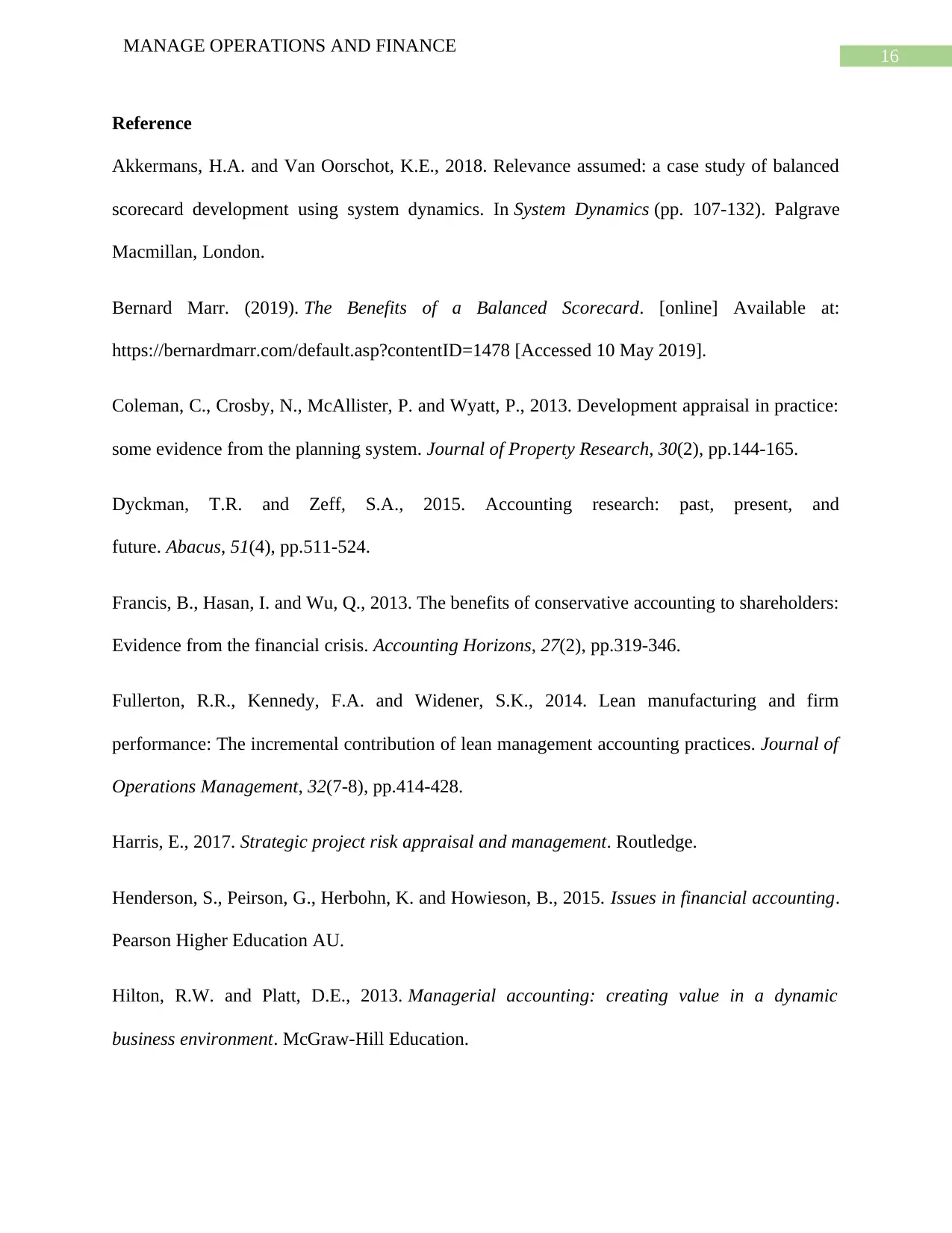
16
MANAGE OPERATIONS AND FINANCE
Reference
Akkermans, H.A. and Van Oorschot, K.E., 2018. Relevance assumed: a case study of balanced
scorecard development using system dynamics. In System Dynamics (pp. 107-132). Palgrave
Macmillan, London.
Bernard Marr. (2019). The Benefits of a Balanced Scorecard. [online] Available at:
https://bernardmarr.com/default.asp?contentID=1478 [Accessed 10 May 2019].
Coleman, C., Crosby, N., McAllister, P. and Wyatt, P., 2013. Development appraisal in practice:
some evidence from the planning system. Journal of Property Research, 30(2), pp.144-165.
Dyckman, T.R. and Zeff, S.A., 2015. Accounting research: past, present, and
future. Abacus, 51(4), pp.511-524.
Francis, B., Hasan, I. and Wu, Q., 2013. The benefits of conservative accounting to shareholders:
Evidence from the financial crisis. Accounting Horizons, 27(2), pp.319-346.
Fullerton, R.R., Kennedy, F.A. and Widener, S.K., 2014. Lean manufacturing and firm
performance: The incremental contribution of lean management accounting practices. Journal of
Operations Management, 32(7-8), pp.414-428.
Harris, E., 2017. Strategic project risk appraisal and management. Routledge.
Henderson, S., Peirson, G., Herbohn, K. and Howieson, B., 2015. Issues in financial accounting.
Pearson Higher Education AU.
Hilton, R.W. and Platt, D.E., 2013. Managerial accounting: creating value in a dynamic
business environment. McGraw-Hill Education.
MANAGE OPERATIONS AND FINANCE
Reference
Akkermans, H.A. and Van Oorschot, K.E., 2018. Relevance assumed: a case study of balanced
scorecard development using system dynamics. In System Dynamics (pp. 107-132). Palgrave
Macmillan, London.
Bernard Marr. (2019). The Benefits of a Balanced Scorecard. [online] Available at:
https://bernardmarr.com/default.asp?contentID=1478 [Accessed 10 May 2019].
Coleman, C., Crosby, N., McAllister, P. and Wyatt, P., 2013. Development appraisal in practice:
some evidence from the planning system. Journal of Property Research, 30(2), pp.144-165.
Dyckman, T.R. and Zeff, S.A., 2015. Accounting research: past, present, and
future. Abacus, 51(4), pp.511-524.
Francis, B., Hasan, I. and Wu, Q., 2013. The benefits of conservative accounting to shareholders:
Evidence from the financial crisis. Accounting Horizons, 27(2), pp.319-346.
Fullerton, R.R., Kennedy, F.A. and Widener, S.K., 2014. Lean manufacturing and firm
performance: The incremental contribution of lean management accounting practices. Journal of
Operations Management, 32(7-8), pp.414-428.
Harris, E., 2017. Strategic project risk appraisal and management. Routledge.
Henderson, S., Peirson, G., Herbohn, K. and Howieson, B., 2015. Issues in financial accounting.
Pearson Higher Education AU.
Hilton, R.W. and Platt, D.E., 2013. Managerial accounting: creating value in a dynamic
business environment. McGraw-Hill Education.
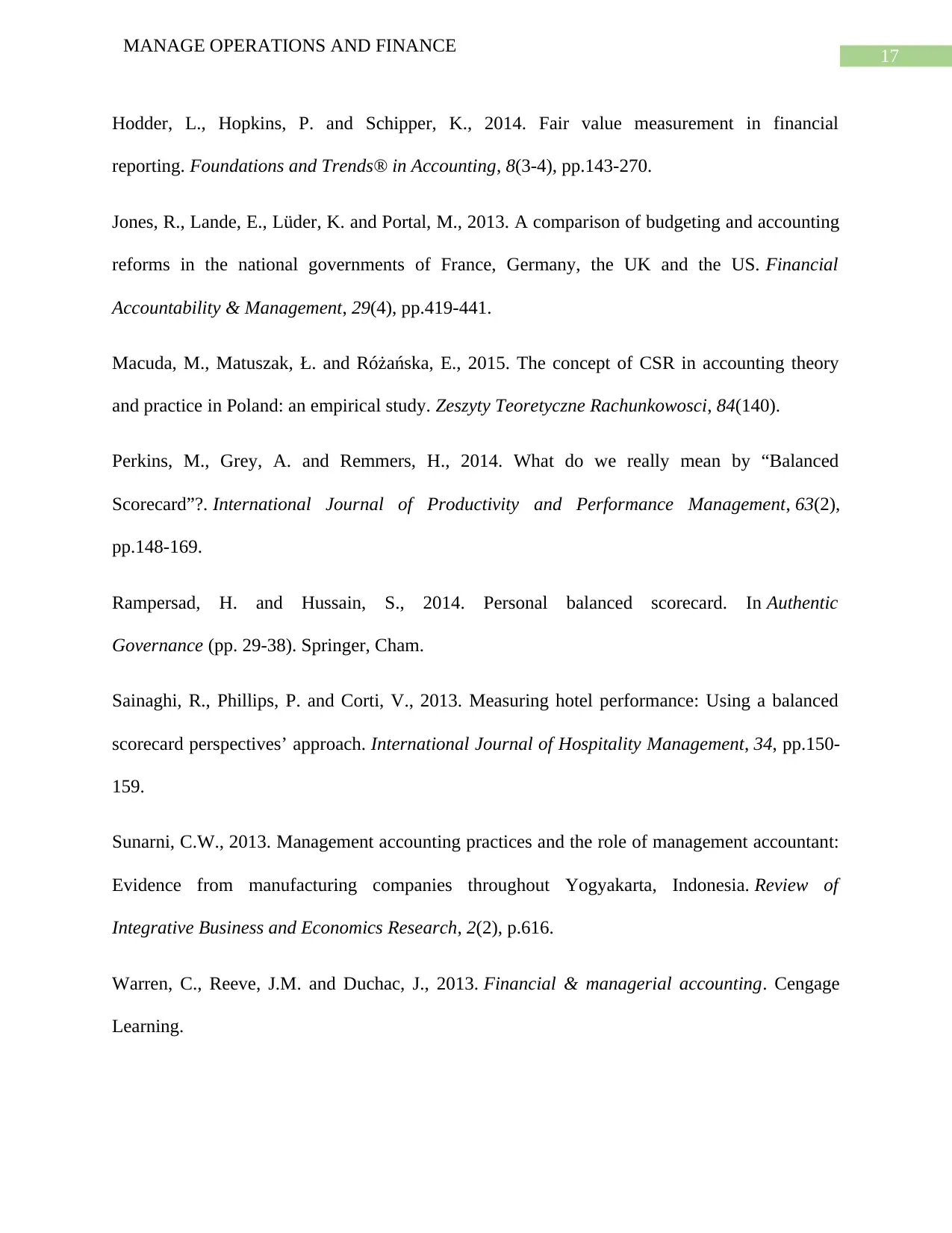
17
MANAGE OPERATIONS AND FINANCE
Hodder, L., Hopkins, P. and Schipper, K., 2014. Fair value measurement in financial
reporting. Foundations and Trends® in Accounting, 8(3-4), pp.143-270.
Jones, R., Lande, E., Lüder, K. and Portal, M., 2013. A comparison of budgeting and accounting
reforms in the national governments of France, Germany, the UK and the US. Financial
Accountability & Management, 29(4), pp.419-441.
Macuda, M., Matuszak, Ł. and Różańska, E., 2015. The concept of CSR in accounting theory
and practice in Poland: an empirical study. Zeszyty Teoretyczne Rachunkowosci, 84(140).
Perkins, M., Grey, A. and Remmers, H., 2014. What do we really mean by “Balanced
Scorecard”?. International Journal of Productivity and Performance Management, 63(2),
pp.148-169.
Rampersad, H. and Hussain, S., 2014. Personal balanced scorecard. In Authentic
Governance (pp. 29-38). Springer, Cham.
Sainaghi, R., Phillips, P. and Corti, V., 2013. Measuring hotel performance: Using a balanced
scorecard perspectives’ approach. International Journal of Hospitality Management, 34, pp.150-
159.
Sunarni, C.W., 2013. Management accounting practices and the role of management accountant:
Evidence from manufacturing companies throughout Yogyakarta, Indonesia. Review of
Integrative Business and Economics Research, 2(2), p.616.
Warren, C., Reeve, J.M. and Duchac, J., 2013. Financial & managerial accounting. Cengage
Learning.
MANAGE OPERATIONS AND FINANCE
Hodder, L., Hopkins, P. and Schipper, K., 2014. Fair value measurement in financial
reporting. Foundations and Trends® in Accounting, 8(3-4), pp.143-270.
Jones, R., Lande, E., Lüder, K. and Portal, M., 2013. A comparison of budgeting and accounting
reforms in the national governments of France, Germany, the UK and the US. Financial
Accountability & Management, 29(4), pp.419-441.
Macuda, M., Matuszak, Ł. and Różańska, E., 2015. The concept of CSR in accounting theory
and practice in Poland: an empirical study. Zeszyty Teoretyczne Rachunkowosci, 84(140).
Perkins, M., Grey, A. and Remmers, H., 2014. What do we really mean by “Balanced
Scorecard”?. International Journal of Productivity and Performance Management, 63(2),
pp.148-169.
Rampersad, H. and Hussain, S., 2014. Personal balanced scorecard. In Authentic
Governance (pp. 29-38). Springer, Cham.
Sainaghi, R., Phillips, P. and Corti, V., 2013. Measuring hotel performance: Using a balanced
scorecard perspectives’ approach. International Journal of Hospitality Management, 34, pp.150-
159.
Sunarni, C.W., 2013. Management accounting practices and the role of management accountant:
Evidence from manufacturing companies throughout Yogyakarta, Indonesia. Review of
Integrative Business and Economics Research, 2(2), p.616.
Warren, C., Reeve, J.M. and Duchac, J., 2013. Financial & managerial accounting. Cengage
Learning.
You're viewing a preview
Unlock full access by subscribing today!
1 out of 18
Related Documents
Your All-in-One AI-Powered Toolkit for Academic Success.
+13062052269
info@desklib.com
Available 24*7 on WhatsApp / Email
![[object Object]](/_next/static/media/star-bottom.7253800d.svg)
Unlock your academic potential
© 2024 | Zucol Services PVT LTD | All rights reserved.





